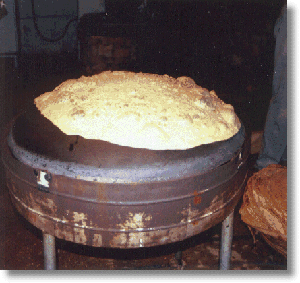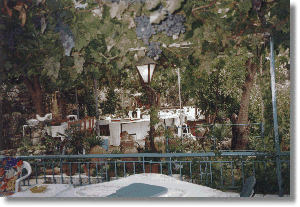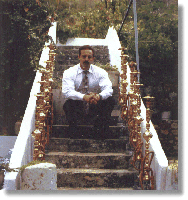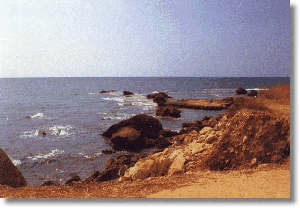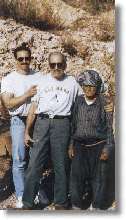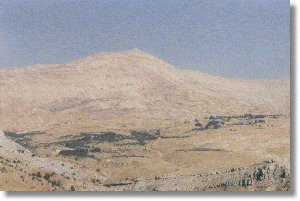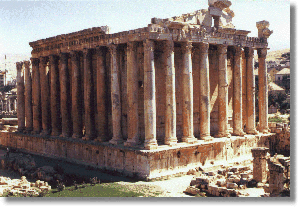By Raff Ellis
In this section of the Journal of Maronite Studies (JMS), we bring you travel accounts of past and current travelers who have written about the Maronites and their environments. These accounts represent the views of their author(s). They may be edited for clarity and style. Former Carthaginians from the Ellis family -- Fr. Kail, Alfreda, Sr. Angele, Raff, and Raff's son, Christopher -- recently made a sojourn to the land of their ancestry, Lebanon. They visited relatives, researched their family tree and saw the sights of the country. The following is an account of the trip from Raff's perspective. "What? You're going to Lebanon! Are you crazy? Going to ride a camel?" That was the first of the response when friends heard of my impending trip to the homeland of my ancestors. Unfortunately, all that most Americans know about that troubled country is what they hear on the news or read in the newspapers. And that coverage tends toward the sensational: terrorism, bombings and kidnappings. Indeed, these were a part of Lebanon's past, and it is hard to shake the image. The State Department doesn't think Americans should travel to Lebanon, and only recently lifted the passport ban that has been in effect for more than a decade. Well, I went anyway and not only did I survive my journey, but I can attest that the country's current reputation is undeserved. Descending into Beirut by air, I see a city in transition, struggling to balance the forces of modernity and antiquity. Construction cranes dot the skyline like a flock of giant birds. It is hard to believe that so many projects can be going on simultaneously. The skeletons of buildings, casualties of the long war, exist alongside emerging high-rises. Roads and other elements of the country's infrastructure also are being rebuilt. Rubble from ruins is trucked to the seashore and used to build jetties that create more precious real estate. Property values are very high because the nation is so small and has such a unique topology. The country measures 125 miles from top to bottom and from east to west, averages 40 miles in width. That space includes two mountain ranges, a coastal strip, an inland plain and many rivers and lakes. Eighty percent of Lebanon's 5.5 million residents--3 million citizens and 2.5 million guest workers--occupy the mid-coastal area, a narrow piece of land some 75 miles long by approximately 1.5 miles wide. The airport is not much different than most, with one exception--the presence of uniformed soldiers at strategic points. It is a little disconcerting for those of us who are used to freedom of movement in the States to see these armed men in camouflage with weapons at the ready, but they are a fact of life in a country emerging from 17 years of internal strife and foreign invasions. On the drive from the airport into the city, Mercedes-Benzes and BMWs race over roads under construction to achieve a single car-length advantage, risking life and property in the process. The game of "chicken" is alive and well in Lebanon, and those who drive must be prepared to play. The few existing traffic signals are ignored. Passing through an intersection is not unlike a swarm of bees trying to get into the hive, all at the same time. Highways have no route designations. Sign posts are scant to non-existent. Cars on a three lane road seemingly shrink to make the road a four lane highway. The drivers do not understand the purpose of the white lines as they straddle them for long distances, abandoning the practice only to pass other cars, right or left. If police cars exist, they are invisible, and the few patrolmen by the roadside seem oblivious to the traffic pattern. Some 2.5 million vehicles are registered in the country, and they all seem to be on the road at the same time. Despite this hellish condition, I never saw an accident or a display of road-rage in nine days of traveling these roads. The drivers are so stoic they resemble zombies, oblivious to the egregious behavior of other motorists (or their own). The most emotion I saw was a gesture with an upturned palm or a muttered tsk, tsk. Our itinerary took us north of Beirut on the Autostrada along the coast into the district of Kesrouan, a 145 sq. mi. area bounded by two rivers; on the north by the Nahr Ibrahim and Nahr el Kalb on the south. We then proceed east, up--and I do mean up--into the mountains, abandoning the hectic coastal road for a different kind of adventure. The road rises steeply, and in less than a half-hour we ascend from sea level to an altitude of 2,900 feet. I kept expecting oxygen masks to drop down from above as we climbed, but that proved unnecessary. The narrow, twisting roads reveal a majestic view of the Mediterranean and the valleys below. Here, the use of the car's horn increases dramatically; drivers toot to warn oncoming traffic as they enter the many hair-pin turns. After dark, flashing high beams serve the same purpose. Somehow, these practices did not augment my already weakened state of confidence. Most often these paved-over donkey trails have no guard rails, and the beautiful but scary view from the car is like looking out the window of a low-flying airplane. Hey, just relax and enjoy the flight! Once the mountains have swallowed us up, we find ourselves in Maronite country--Maronites being members of one of the many Eastern rites of the Catholic Church. These Lebanese Christians are unabashedly devoted to the Virgin Mary, placing shrines of varying sizes along the roadside. Each enclosed structure has votive candles and a statue of the Blessed Mother. (Picture the shrine along the Herrings Road, some larger, some smaller, being repeated every ½ mile or so, and you'll have an idea of what I'm talking about.) On our journey into the mountains, we pass through numerous villages and towns. The ancient pathway takes us through the heart of each of these bustling centers, whose gas stations, grocery stores, pharmacies, restaurants and shops cater to the needs of the surrounding residents. There are no vacant storefronts here and, coincidentally, no shopping malls. Little room for expansion has fostered an allegiance to "mom and pop" stores. Small town America should be so lucky. As we continue the drive, I can't help but take note of the precipitous nature of construction in the area. Houses are perched on land that has been gouged out of hillsides. New buildings, all made of concrete and stone, are in various stages of construction. Eighty percent of the rock in these mountains is limestone, providing a plentiful supply of building material. Blast and build seems to be the byword here. Surprisingly, there is a profusion of private agriculture in these craggy mountains. Gardens and orchards are etched into the hills and terraced with rocks that have been cleared from the land or dynamited loose to make room for houses. It is mandatory, it seems, that everyone have their own victory garden (only those old enough will remember what those were). Besides tomatoes, cucumbers, radishes, peppers, lettuce, endive, onions and squash, the Lebanese cultivate a wide variety of herbs, including parsley, bay leaf, mint, rosemary and thyme. The diversity of fruits and nuts are a wonder to see and taste. Apples can be huge--as big as small melons--and there are also grapes, figs, pears, avocados, lemons, limes, oranges, melons, pomegranates, bananas, and more. All meals begin with freshly-picked vegetables and end with fresh fruit and raw nuts, such as pistachios and almonds. This was the first time I ever tasted fresh figs, and they were delicious. With this diet, one has no trouble getting their daily five servings of fruit and vegetables, ala the American Heart Association recommendation. In short order we arrive at the ancestral home of our mother, Angele Hobeiche Ellis, in Qattine, a small village in Kesrouan. Snuggled into a hillside, the house commands a view of the valley below and the road that brought us here. Looking out on the gardens and orchards, the mountains and valleys, we now better understand why mother often pined for home, with its fresh mountain air, mineral spring water, and the many fruits and vegetables grown on the property. The house is now occupied by our cousin, Sheikha Johainna Hobeiche,
who has come home after many years abroad in France and Kuwait. After the
required "salaams" and three kisses each, a feast awaits us. How anyone
is supposed to do justice to the wide variety of appetizers, called mazza,
that are served is a mystery. The Lebanese are famous for their mazza,
a smorgasbord that includes dishes containing dips made from sesame paste
and eggplant or chick peas; a variety of bean dishes; tabuli and fatoush
salads; yogurt cheese; olives; stuffed grape leaves and tiny squash; pickled
turnips; small pastries filled with spinach, onions, pine nuts, ground
lamb or cheese; and baby eggplant stuffed with walnuts, garlic, rice, and
chili peppers cured in olive oil. These are accompanied by copious amounts
of marqouq, a flat bread that is baked on a gas-fired, inverted wok-like
structure that creates a paper-thin loaf, great for scooping up the tasty
morsels. The main course includes kibbie, a ground lamb dish that is served
either baked or fried; stuffed cabbage; shish kebabs of lamb and chicken;
and shawerma, a garlicky, roasted lamb sliced very thin. This, of course,
is followed by sweets such as buclawa, halawa, date and walnut cakes along
with fresh fruit and Turkish coffee. All during the meal the Sheikha watches
to make sure that we eat enough, insisting that we take more of this or
that. The Lebanese reputation for hospitality is well deserved. Forget
about that diet you were on!
The next evening, 50 or so members of the Hobeiche clan gather for a
mass said by Fr. Kail at Mar Elias, the family church in Ghazir that was
constructed in the 1600s. The unique architecture features rose-hued stone
walls climbing to an arched ceiling and doorways so low one has to stoop
to enter. (The height, I am told, was kept low to prevent the Ottoman oppressors
from riding their horses into the church.) The crypt below the church contains
the remains of many Hobeiche family members. It is here that our mother,
Angele, and her mother, sister, and brother are interred. Among those at
the gathering is The Honorable Fouzi Hobeiche, Minister of Education and
Antiquities. Cousin Fouzi is tall and charming--he certainly must have
gotten the ladies' vote--with a commanding presence that exudes the confidence
of a successful politician. Fouzi makes the rounds, welcoming each of us
back "home" in his excellent English. Of course, afterwards, the feasting
at "Cafe Johainna" is repeated in even grander style than before--complete
with enough nargeelies, the pipe that filters tobacco smoke through water,
to go around.
The mountain air is cool in the evening, and we need covers when sleeping. The mosquitoes are pesky though--you never know you've been bitten until two days later when the scratching begins--so a repellent is required. The roosters greet the coming dawn, seemingly an hour before light, and it's not long after rising that the feasting begins anew. Breakfast consists of an array of baked treats similar to pizzas. The staple, manooshi, is made of thyme, sesame seeds and olive oil baked on a thin crust. Other thin pizzas contain cheese, squash, onions and ground lamb. In addition there are the ubiquitous cracked green olives, yogurt cheese, coffee and tea. Vegetables and fruit are, of course, de rigueur, and these people haven't even heard of the American Heart Association. Another aspect of Lebanese hospitality, besides the wonderful food, is the uninhibited way in which people drop by unannounced for visits, which evokes memories of the Carthage of my youth. Most of these people carry cell phones, but they wouldn't think of calling beforehand. At any time of the day or night, they come by to sit and talk for hours on end about a variety of subjects: medicine, when a neurologist dropped in; military politics, when an army colonel came by; and Lebanese history, when a scholar was over. We have a lot of fun stumbling over the translation of uncommon words--in three languages, no less! I can't help but feel that we have lost something in the States with the passing of the unplanned visit. The next day, Johainna wants to take us higher up into the mountains to see an old church and the great view it affords, and to gather walnuts. We ascend to an elevation of 4,800 feet to Chatoul, and can clearly see the ocean in the bay of Jounie, nearly five miles away. The peak above is named Jabbal Jouze, Walnut Mountain, because of the profusion of walnut trees that dot the hillside. The journey also gives us an opportunity to experience an interesting phenomenon: the fog rolling in at any time of day. It is noon and the sun is shining, but soon it clouds up and we can see the mist start at the lower elevations and quickly come up the valleys until visibility is less than 50 feet. Then, just as quickly as it came, it is gone--thankfully, because I shudder to think what it would be like to traverse these roads shrouded in fog! Among the many sights to see in Lebanon are the marvelous caverns of Jeita, which lie 20 kilometers north of Beirut. Discovered in 1836 by an American missionary, Rev. William Thompson, the Jeita Grotto is the principal source of the Nahr el Kalb, or Dog River. The cave consists of two levels: an upper gallery, which is traversed on foot to a distance of 650 meters, over a walkway that is an engineering marvel in its own right; and the lower level, which is negotiated by boat over 500 meters of green water that maintains a constant temperature of 60 degrees Fahrenheit. Formed several million years ago, Jeita's flowing draperies, stalagmites, stalactites and pools are among the most spectacular in the world. Mammoth Cave in Kentucky, which I've visited, is Spartan by comparison. Although I have seen the Jeita caverns before, at the modest admission charge of $12, they are definitely worth seeing again and again. Overlooking the Nahr el Kalb river valley is the monastery of Christ the King, which has a huge sculpture of Jesus, reminiscent of the famous statue overlooking Rio de Janeiro. Along the rock walls surrounding the valley, various invaders of Lebanon chiseled their names and carved out plaques, noting their conquests or praising their commanders. The older inscriptions date from the 7th century BC and commemorate a procession of foreign leaders: Assyrian kings; the Egyptian, Ramses II; the Babylonian, Nebuchadnezzar II; the Roman, Marcus Aurelius Antoninus (Caracalla); and the Greek, Alexander the Great. More recent inscriptions record Napoleon III's incursion in 1860; the occupation of the British and French Palestine Corps in 1918; the French invasion under General Gouraud in 1920; the Australian Army's conquest of Damour in 1941; and the French and Allied armies arrival in 1942. These antiquities date to 2,200 years before Columbus discovered America, and they sit out in the open with traffic whizzing by, subjected to the ravages of the elements. I can't help but wonder why they are not better taken care of, as some of these relics are already unreadable. I must make a note to speak to cousin Fouzi about this. Driving along in the urban areas of Lebanon, one can't help but notice the American business influence. Signs are predominately in English, followed by Arabic and then French. Fast food outlets abound, including Pizza Hut, KFC, Denny's, Hardee's, Sbarro and Baskin & Robbins. Why anyone would want to eat that junk, with the great food they have, is beyond me. Most middle-class Lebanese speak three languages--Arabic, French and English--and some have added German as a fourth tongue. Shopping is facilitated by the ability to "bargain" in one's native tongue, although haggling is not as animated as it used to be. With the rising standard of living, fixed prices have become more common, along with the use of non-family members as clerks in the shops. These clerks, of course, conveniently claim no power to alter pricing. That didn't stop me from trying however; it's imprinted in my DNA, after all. On previous visits in the 1970s, the American dollar was exchanged for no more than three Lebanese pounds. That rate held until 1983, when rampant inflation took hold. After eight years of war, the government started to print money because of obligations it could not meet and the rate of exchange quickly began to rise. In 1984, the exchange ratio rose to 90 to 1, and peaked a few years later at 3,200 to 1. Today, the rate hovers at 1,500 Lebanese pounds to the dollar. US currency is regularly used as the medium of exchange, and clerks quickly tell you the price in either currency. It is mind-boggling to look at a price tag of 10,000 LL. and realize we're only talking about $33. Ironically, I never had to exchange US currency until I visited the American University of Beirut (AUB), which would not honor the American dollar. Although all instruction is in English, the American University is not as American as I had thought! The university's lovely campus of 50 buildings is spread over 70 acres that command a gorgeous view of the Mediterranean. Like the rest of the country, the university is undergoing a building program, adding a large new administration building and making long neglected repairs. AUB serves approximately 5,000 students and has a modern library with a computer-assisted reference system. Speaking of universities--of which Lebanon has an overabundance for such a small country--Fr. Kail is on the board of one of them, Lebanese American University (LAU). As a result of this association, we were invited to a social function at the Jbeil campus and it was a party to behold with music, Arabic dancing and enough food to feed a small third-world country. The university has two other campuses, at Beirut and Sidon. The battle between old and new is most apparent in large cities, where obvious poverty is juxtaposed with affluence and indulgence. Hardly anyone in the middle class is without a cellular telephone, satellite TV, VCR, and even a laser disk player for watching the latest movies. Live-in domestic help is also common, with the majority of them coming from Sri Lanka. It is amazing at how quickly they adapt to learning the language and preparing the local menu. These guest workers--who cook, clean and take care of the children--make from $100 to $150 per month, with most expenses paid. They are retained on a six-year contract and it is claimed that they go home "rich" after their time is up, with $6,000 or $7,000 in their possession. The Lebanese middle-class have a reputation for being able to live beyond their means and no one quite knows how they do it. Although automobiles are quite expensive (about double US list prices), Porches and Ferraris are often seen, as are Peugeots and Citroens. Mercedes is the automobile of choice for the well to do, and a $200,000 price tag does not appear to be a barrier. The donkey cart, although not as prevalent as in years past, still exists. Peddlers with pushcarts are common in the urban areas, and young lads still sell Chicklets and hawk shoeshines. I had a hard time convincing one of them that my moccasins didn't need a shine! A few days into our visit, we find ourselves becoming braver with regard
to the hectic traffic. Since no drivers are available, Chris and I take
our cousin's Peugeot and venture out to tour Jbeil (ancient Byblos), reputably
the oldest continuously inhabited city in the world. I am not worried (not
much, anyway), because Chris is a graduate of Skip Barber's racing school,
and he takes to the demonic traffic like a Formula One driver, gobbling
up the vacant asphalt between cars, no matter how small. (Aware of my apprehension,
Chris suggests I read the map and guide book and not watch the road.) Jbeil
holds an interesting sidelight for us because another of our politician
cousins, this time from our father's side of the family, is the mayor of
the ancient city. Unfortunately, we don't get a chance to meet him.
The city of Jbeil has excavated many ruins, such as a Neolithic village dating to 5200 BC. The Greeks gave the town the name Byblos, meaning paper, because they bought papyrus from here. As we stroll along the seashore of the old port, we cross acres of pretty, multicolored stones, several of which we convert into souvenirs. The scenery is so beautiful that my mind automatically ignores the thoughtless pollution that litters the seashore. The port is guarded by watchtowers that are now topped with beacons to guide ships that use the harbor. Many of the buildings date from before the Crusades and were built with stones salvaged from ancient Roman temples. Centuries old sandstone blocks, showing the ravages of time, look as if worms had been having a feast on them. One gets the sense of olden times here, what with the weathered walls, antiquated construction, winding streets and castle remnants. It's a bit awe-inspiring to think that we are walking on paths that civilized people used some 7,000 years ago. One of the highlights of my visit is shopping for an antique lamp to grace the dining room of the house I'm building in east Orlando. Many years ago in Egypt I saw some old oil lamps that had hung in mosques, and thought I would like to get one if ever the opportunity arose. My cousin Alain Joseph's wife, Desiree, takes me to a strip-row of antique shops in the suburbs of Tripoli that might have what I am looking for. In one of the many stores, all owned by the seven Hassoun brothers, I find exactly what I want: an ornate copper lamp, reputedly 150 years old, approximately three feet in height with blue, red and green glass. It looks like something out of The Arabian Nights. Haggling for the chandelier requires some heavy artillery in the form of a business associate of Alain's who knows the Hassouns and is able to get the item for about 65% of the asking price--10% less than my best haggle. Alain, who heads a successful architectural firm, always seems to know whom to call for whatever purpose. (By the way, after nearly four weeks in transit, the lamp arrived in Florida with only minimal damage and is in the process of being restored. I rubbed it and, darn, no genie popped out!) An interesting part of the trip unfolds when we venture up the mountain to Bqaatouta, the village of our father, Toufee Kmeid Ellis, and most other Lebanese in Carthage. We ascend over winding roads to an elevation of 4,000 feet to find a small farming community of about 500 permanent residents. During the summer, the population triples to 1,500 because so many people covet the seasonal mountain weather. The town center has a Church, a cafe and not much else. Our father's house no longer exists, having been replaced by a modern stone mansion belonging to an Elhage. The mayor of Bqaatouta is also an Elhage, Charbil by name, whose main occupation is as a bodyguard to the foreign minister. On our way we pass the former home of Amin Abbass, patriarch of the Abbass family of Carthage. We then find the house of a cousin, Amin Kmeid, who welcomes us and tries to answer questions about family history. Fr. Kail, Amin and Tanios Kmeid, a first cousin of the Solomons of South Mechanic Street, pore over the family tree together. Precise dates are elusive, however; it seems in the old days, when people died, the priest came and said a few prayers over the grave, and that was the end of it--no headstones were erected. The records that were kept were lost in a church fire many years ago. We have only the memories of the elder citizens to go by. The town inhales us and breathes out a lot of familiar faces. Each of
us in turn exclaims: "Doesn't that look like _____?" Substitute any of
the many Lebanese names in Carthage and you can find someone that looks
like a member of that family. Amin takes us to the town church and proudly
points out an oil painting that hangs above the altar. The inscription
notes that the art work was donated by our father Toufee and his cousin
Naja Ellis (from Tupper Lake) in 1925. From the church we go for a ride
and find a few men working in an apple orchard; more cousins, it turns
out. One of the men is 95-year-old Harris Kmeid, my father's first cousin,
once removed. He is the only person alive who actually remembers my dad
as a boy. Harris, who is as spry as any 60 year old, has a sharp mind,
a keen eye, excellent hearing and thick head of pure white hair that I'd
kill for. We spend a couple hours with Harris, recording his reminiscences.
When asked for his secret to long life, he responds, "I work too hard,
drink good mountain water and eat only the foods that we grow ourselves."
Incidentally, Harris--who did not marry until age 50--and his wife, who
is 30 years his junior, live in a small house that once was the home of
our great, great, grandfather Elias, from whom we derive our Anglicized
surname of Ellis.
While in Bqaatouta, our cousins offer us a tour of the Sannine bottled water plant where Harris' son works. (Harris eschews any assistance to mount or dismount the steep loading dock!) The plant derives its name from the majestic 8,600-foot Mount Sannine, that overshadows the little town. Mineral water is a big business in Lebanon, as every restaurant routinely puts a large bottle on your table. Everything needed for producing Sannine mineral water is made inside the modern plant: bottles, caps and packaging. The product is pumped up from wells, 90 meters or so deep, that contain ancient trapped water. The liquid lies beneath a layer of impermeable clay and thus is not subject to contamination from any kind of infiltration. It comes out of the ground with zero bacteria level and only trace amounts of iron. Care is taken to insure that the water goes from the well to the bottle without exposure to the air. It was interesting to watch the automated production lines pump out bottle after bottle of the delicious water. I hint to the plant manager that it would be nice if we could purchase some of their product. Shortly thereafter a dozen liter bottles mysteriously appear in the trunk of our car! They were added to the two large boxes of Bqaatouta apples that Harris' clan had provided. No visit to Lebanon is complete without a trip to the legendary ruins of Baalbek. This magnificent example of Roman temples actually contains the architectural remnants of three religions: pagan, Christian and Muslim. The Venus, or Bacchus temple is the most complete Roman temple in the world. How the builders brought the large stones from as far away as Aswan, Egypt, is a mystery. The drive on present-day roads over the mountains to reach the site is difficult enough and the thought of dragging objects weighing 45 tons and more is overwhelming. Legend has it that Marc Antony once gave Baalbek to Cleopatra, and among the ruins is a bas-relief of the famous couple. Anyone interested in mythology can spend many hours here identifying various gods and goddesses depicted on the walls. By the way, the Baalbek Festival--once the grande dame of performing arts events in the Middle East--returned in July after a hiatus of 23 years! Mstislav Rostropovich performed with the Orchestre Philharmonique de Radio France beneath the floodlit temples. The Festival played for seven days, a far cry from its six-week schedule when it was last held in 1974. Tour groups from France, Germany and England were in attendance as Lebanon--once one of the most popular Middle East travel destinations--is again becoming a desirable tourist stop. Now my trip is nearly over and I haven't seen half of the interesting sights--nor, by the way, any camels, which do not inhabit Lebanon! So, Chris and I will return home, leaving my siblings to enjoy Lebanon for a few more days. My cousins lament the fact that it is such a short stay. "You must stay at least a month," they say. However, the die is cast, with uncancealable reservations and all, so I pack for the trip back home. My driver says we have to be ready to go at 5:30 am, and so we are. The drive into Beirut at that time of day is refreshingly pleasant as the traffic is light. There is no hassle at the airport; my bags were never inspected, coming or going. While waiting for our flight, I strike up a conversation with another American, from San Diego. He has a Lebanese wife and has just spent two months in the country. "I come every year," he says, "and usually stay for six months." He was in the US Marine Corps, stationed in Lebanon in 1958--for a total of two months--and took home a "war bride." The man has learned to speak Arabic and is an unabashed good-will ambassador for Lebanon. He insists on telling me the story of how he purchased a set of false teeth at a Gypsy camp on the outskirts of Tripoli. "Only cost me $130," he exclaims, "and they fit perfectly!" I meet all manner of interesting people at international airports. My trip to Orlando takes the better part of 14 hours of flying time, and I'm glad to be back. When I get home, I am afraid to get on the scales because of my nine days of profligate dining on rich foods. To my astonishment, I weigh exactly the same as when I left! It must have been all those vegetables. During my visit, I saw some of the Lebanon of my ancestors and some of the Lebanon of today--the one beyond the sound-bite of the evening news. Of course there are areas where the Lebanese need to improve--such as resolution of the frequent power outages, improved sanitation, prohibition of littering, attention to the environment and public transportation. Based on my conversations with the younger generation, they are very interested in these areas. Nonetheless, the propaganda you hear about the dangers of visiting there is way overblown. There have always been vested interests that want to keep Lebanon from asserting itself as a commercial center for the Fertile Crescent. But, knowing how resourceful these people are, it won't be long before the country takes its rightful place as an economic power in the region. So, as you will so often hear in Lebanon, salaam alikum--may peace be
with you.
|
